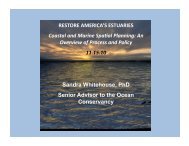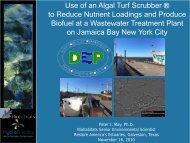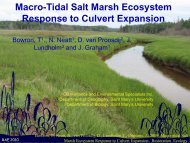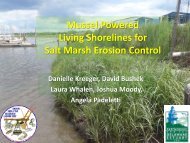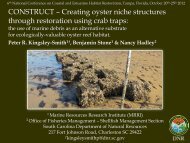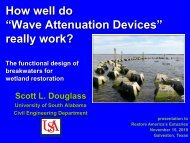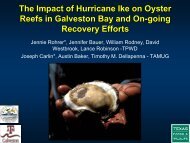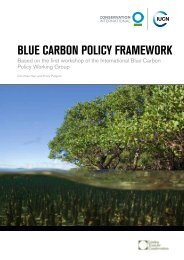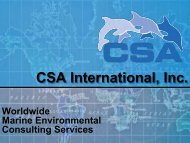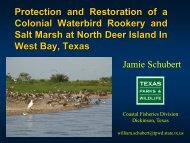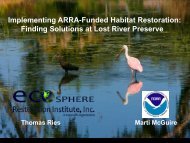Advancing Anadromous Fish Passage Efficiency Lower Shannock ...
Advancing Anadromous Fish Passage Efficiency Lower Shannock ...
Advancing Anadromous Fish Passage Efficiency Lower Shannock ...
- No tags were found...
Create successful ePaper yourself
Turn your PDF publications into a flip-book with our unique Google optimized e-Paper software.
<strong>Advancing</strong> <strong>Anadromous</strong> <strong>Fish</strong> <strong>Passage</strong> <strong>Efficiency</strong><strong>Lower</strong> <strong>Shannock</strong> Falls Dam RemovalPawcatuck River, Rhode IslandJames Turek 1 , Nils Wiberg 2 , Dick Quinn 3 , Mike Trumbauer 4 ,Kathy Hoverman 4 ,Sean Arruda 2 , Amy Hunt 2 , and Chris Fox 51National Oceanic and Atmospheric Administration, Narragansett, RI;2Fuss & O’Neill, Providence, RI; 3 U.S. <strong>Fish</strong> and Wildlife Service, N. Attleboro, MA;4KCI Technologies, Sparks, MD; 5 Wood Pawcatuck Watershed Association, Hope Valley, RI
<strong>Lower</strong> <strong>Shannock</strong> Falls Dam Removal, along with HorseshoeFalls <strong>Fish</strong>way and Kenyon Industries Dam RemovalARRA Award, June 2009ImpoundmentKenyon Industries DamDamHorseshoe Falls Dam<strong>Lower</strong> <strong>Shannock</strong> Falls Damand Impoundment
Pawcatuck RiverWatershedProjectSiteRhode IslandMap Source: WPWA
<strong>Fish</strong> <strong>Passage</strong> Goal:Unimpeded <strong>Passage</strong>by Target Species andDesign CriteriaTarget Species:‣Alewife (Alosa pseudoharengus)‣Blueback herring (A. aestivalis)‣American shad (A. sapidissima)‣Atlantic salmon (Salmo salar)‣American eel (Anguilla rostrata)‣Resident fish species (e.g., Brook trout)1,043-Acre Worden Pond85 mi 2 WatershedAlosid Run Period Design Flows:‣10% Non-Exceedance = 85 cfs‣50% Non-Exceedance = 175 cfs‣90% Non-Exceedance = 356 cfsWorden Pond OutletAlosid Run Period Minimum Design Depth:= 9 inches; Maximum Velocity = 7ft/s<strong>Fish</strong> Flow, HEC-RAS, Hydraulic Analyses: KCI TechnologiesPawcatuck River
<strong>Lower</strong> <strong>Shannock</strong> Falls DamPre-RemovalLow FlowHigh FlowRun-of-the-river dam7-ft height (4-ft high structureon bedrock), 105-ft length500-Year Event(March 2010)
Site ConditionsHistoricSmoke Stack(Preserved)Knowles Mill Remains (Removed)Impoundment (13+ ft deep)Mills Remains in Downstream Riverbed
Dam Removed
Former Dam and Bedrock Ledge
Weir ConstructionJuly-August 2010Rock ExcavationPlans: Fuss & O’NeillPhotos: C. Fox
Weir 1Weir Constructionand ModificationsWeir 2Void Filling with SandWeir Notch Measurements
Boulder Placementfor Flow Pattern ModificationAugust 26, 2010Sand Bag Placement Testfor Backwatering EffectsPhotos: Fuss & O’Neill
Test Flow MeasurementsAugust 26, 2010Photos: Fuss & O’Neill
Weir 143 FeetWeir 2Weir 3As-built in boldDesign inParentheses(PreliminaryResults)Backwatering weirs at 90 cfs flow (11 November 2010)
90 cfs Flow at WeirsExpected Alosid Migration RouteUpstreamDownstream
Natural Grade DropsExposed withImpoundment Drawdown
Cost Summary<strong>Lower</strong> <strong>Shannock</strong> Falls Hybrid Dam Removal(Dam Removal with Nature-like <strong>Fish</strong>way Component)Feasibility Assessment = ~$42,300Design and Permitting = $187,260(Included SHPO coordination, public workshops, easements)Construction and Oversight = $588,910(Included removal/disposal of 105 cy contaminated sediments, wellreplacement)Post-Construction Monitoring = ~$25,000Total Project Costs = $843,470Cost/Foot-Rise for Construction = $82,000
Lessons LearnedOrganize project team that is well experienced in fishery biology,hydrology/ hydraulics, sediment transport, and water managementComplete nature-like fishways in “dry” conditions to achieve elevationsand other design features requisite for fish passage; test flows duringconstruction if possible to make flow modifications benefiting fishConduct routine post-removal monitoring of target fish presence/abundance and flow depth and velocity at dam removal/nature-likefishway sites to determine if passage goals are metRecognize that quantitative passage performanceevaluation may require 3-5+ years to concludewhether goals are metMonitor post-dam removal site conditions for 3+ years including upstreamriver channel and bank stability, and riparian wetland community metrics




